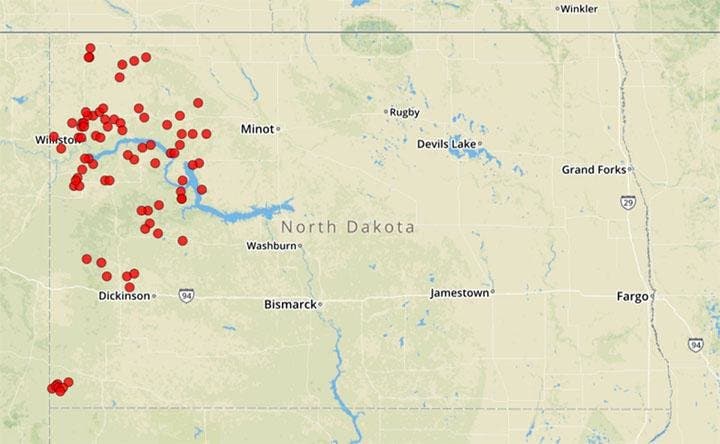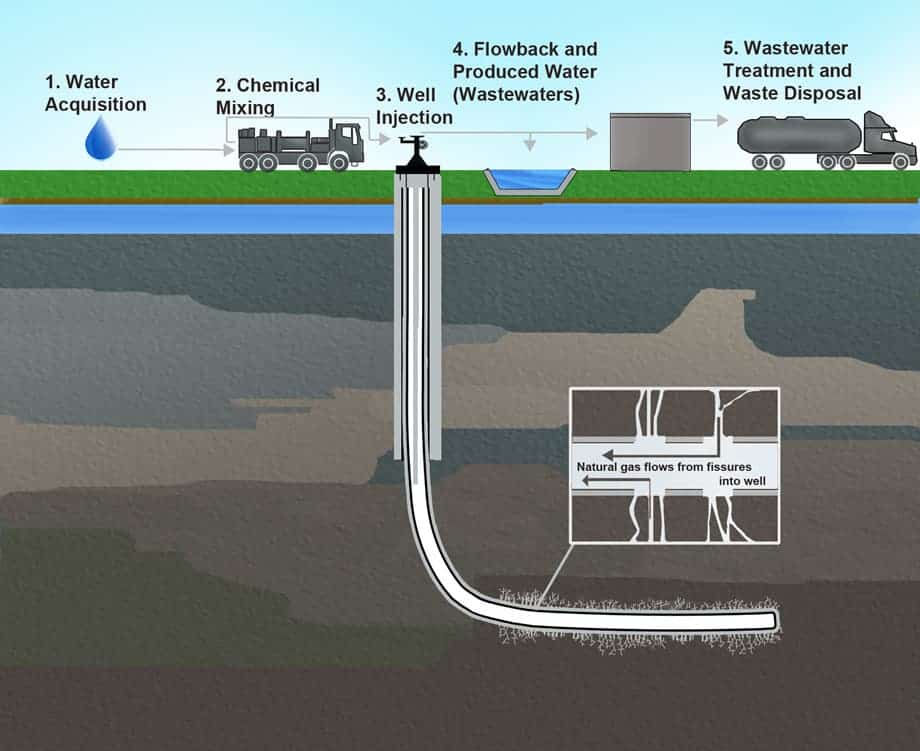The controversial practice of hydraulic fracking is much more damaging than we actually thought. These oil and gas wells spill pretty often to the surface, a new study found.

This is a screengrab from the study’s interactive map shows a decade’s worth of spills of more than 5,000 gallons of pollutants from pipeline leaks at North Dakota hydraulic fracturing sites.
Credit: Source: Science for Nature and People Partnership
As any geology student worth his salt will tell you, oil reservoirs are complex things. First, you need a source rock under just the right temperature and pressure — to generate the oil. Then, you need a porous rock to hold the oil, and a seal to prevent it from migrating towards the surface and spilling (because oil is much lighter than surrounding rocks). The fact that oil reservoirs exist in the first place is pretty neat in the first place.
But sometimes, you need to give Mother Nature a hand to be able to get that sweet oil. Specifically, you have to generate a system of fissures through which the oil and gas can get closer to the surface, so you can extract it. This is done by injecting a so-called fracking fluid at extreme pressures with the purpose of splintering the rocks and creating a system of fissures. There are several major environmental problems associated with this practice.
For starters, we don’t really know what the fracking fluid is — it’s considered to be a corporate secret — but we do know that it contains a slurry of chemicals, many of which can be dangerous to humans and the environment. Secondly, this takes up gargantuan quantities of water (millions of gallons per well) which can exert a massive stress on local aquifers. Some of the water can be reused from well to well, but much of it is lost. Also, there have been studies linking fracking to increased seismicity and water contamination, as well as increased greenhouse gas emissions. But unlike previous studies, which analyzed what happens beneath the ground, this one focused on the surface.
Researchers studied 31,481 hydraulic fracture wells, finding that between 2004 and 2015 there have been 6,648 spills, as defined by each of the four state’s reporting requirements. These spills to the surface can have a huge negative impact on the environment and drinking water.
“There’s been so much focus on the ground water contamination and the casing incidences,” says Hannah Wiseman, the Attorneys’ Title Professor at Florida State University College of Law and an author on both studies. “We wanted to sort of shift the attention a bit to the surface.”
It’s not the first time a study like this was carried out. A similar study conducted by the EPA found only 457 leaks between 2006 and 2012 — but that’s because they only looked at spills caused by the fracking itself. This is more of a lifecycle analysis, showing that for the entire duration of the project, fracking wells can, and often do, leak to the surface.
“We think it’s important to study the whole life of the well,” said Wiseman, “because the process of hydraulic fracturing has enabled the drilling of so many more wells.”
In total, they found that 2 to 16 percent of fracking wells spill hydrocarbons, chemical-laden water, hydraulic fracturing fluids and other substances into the environment. That’s a total of 6,648 spills reported across Colorado, New Mexico, North Dakota and Pennsylvania in the 10 years.
Researchers have even developed an interactive map where everyone can check the oil spills at both national and state level and find out more about them. Who knows, there might be one near you.
Of course, the timing of this study is extremely important. With the newly-elected Trump administration vowing to bring back America’s fossil fuel industry, there are more and more concerns regarding our objective of limiting climate change. By now, it should be clear that fracking is not the answer to the world’s rising energy demands and the negative effects clearly outweigh the positives. But in the meantime, as the technology is still ongoing in many parts of the US, it’s important to quantify what its effects are in order to delimitate and mitigate the risks to water supplies and human health
Journal Reference: L. Patterson, K. Konschnik, H. Wiseman, et. al. Unconventional Oil and Gas Spills: Risks, Mitigation Priorities and States Reporting Requirements. Environmental Science & Technology, 2017 DOI: 10.1021/acs.est.05749










